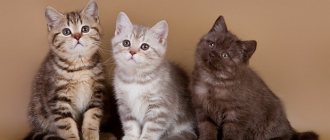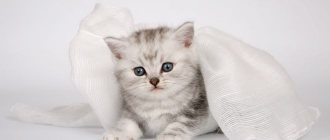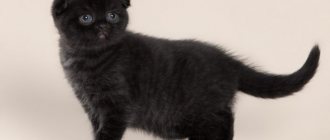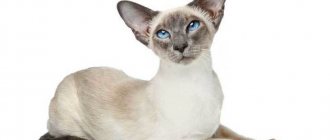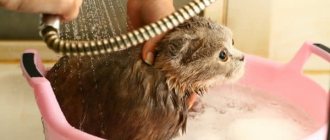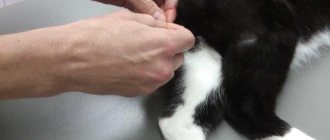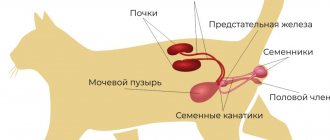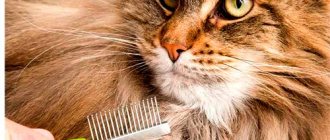British newborns, what they look like, photos
Outdoor cats choose dark, warm places to give birth, usually basements and attics. At home, you need to provide a “birther” for the British woman. It can be made from a large box, 60x60 cm in size, 40 - 50 cm high. Store banana boxes and exhibition tents are suitable. Lay out a diaper for animals and a heating pad.
Depending on the number of kittens in the cat’s womb, a newborn kitten can have a body length of 8 - 12 cm, the weight of kittens is from 70 - 120 g, there are small ones of 50 - 60 g, this happens when there is a multiple pregnancy. Weight table here.
The British are born blind, deaf, with large claws, without undercoat, the fur is not able to warm the baby, so you need to monitor the temperature of the “birthing place” ≈ 38 - 39 C⁰. At the age when kittens sleep 95% of the time, their innate sense of smell and touch allows them to find the cat's nursing nipple. The British mother licks the kittens; without her, they are unable to defecate. In the period from birth to 2 - 3 weeks, you should monitor the daily weight gain of babies by 10 - 20 grams, they should be weighed in the morning at the same time. If someone does not finish eating, then put it on the nipple more often.
Stages of development of a newborn British baby by day:
- Days 1 – 3 – baby sleeps, eats; how to determine the sex of newborn kittens is described in detail here
Plush kittens at 1 week
During this period, babies begin to crawl more actively, and many begin to open their eyes. Children's undercoat is formed and they react more actively to sounds.
It's time to increase the area for cats, choose a name.
Video of the British in 10 days below.
Little kitties 2 weeks old
British Shorthairs grow quickly, their weight has tripled since birth. They began to sleep less, eat less often, but the portions became larger. They begin to walk unsteadily, with long claws allowing them to maintain balance. By the end of the second week, the eyes open, they will immediately be a little cloudy. The first eye color is blue. They are seen a couple of days after opening on days 14–17. They hear the cat better and respond to its purring.
British 3 weeks
Kitties see and hear everything, sit and walk confidently, and try to jump. Baby teeth are visible. They are very curious and try to get out of their beds, so it is worth using fences and playpens. The area for children to play should be increased. Provide a scratching post, soft toys, a tray with filler and water.
The cubs actively play with each other, bite and hiss, and practice hunting skills.
Kitten 1 month
The period of appearance of bear-type kittens. Month-old kittens are formed unevenly; a large body on short thick legs reminds us of a small bear. They sleep 16–20 hours, are very active, and play a lot.
Month-old kittens drink water on their own for 4 weeks, many eat wet and dry food themselves, and go to the litter box. Time to work with the kitten and adapt to the hands, teaching manners. The “change of color” of the eyes from blue to orange (for blue color), this happens gradually.
5 – 6 weeks | After 1.5 months, the kitten licks its fur and washes itself, the undercoat thickens, and the color becomes brighter.
At 7–8 weeks, babies are still drinking their mother’s milk and learning cat wisdom from her. The eyes acquired their color, became bright and clear.
Constant sleep of newborns - an alarming signal or normal development of the body
Newborn kittens sleep up to 22 hours a day. This is not a cause for concern, because at this time the baby’s nervous system is developing. Sleep contributes to the favorable course of this process. In the first months, the kitten should not be separated from its mother and brothers and sisters. If his weight is normal, it means that development is proceeding normally, and constant sleep is conducive to this.
Newborn kittens sleep up to 22 hours a day
You can familiarize yourself with sleep norms for the initial stages of a kitten’s life in the table.
| Age | Image | Number of hours of sleep |
| Newborn | 22 | |
| 3 weeks | 16 | |
| 1 month | 15-20 |
In order for a kitten to switch to nighttime sleep mode, it should be provided with sufficient activity during the day: play, run. Thus, by night he will be tired, sleep will be necessary to restore strength and will coincide with the biorhythms of the owners.
British kitten 2 – 3 months
Kittens feed themselves, go to the toilet, and play. They are very curious and it is worth taking care of their safety: close the windows, remove poisonous plants, dangerous sharp toys, threads, buttons. They suck a cat out of habit; they will do this until they are weaned or the cat stops letting them come to them. The paws of kittens lengthen and no longer resemble bear cubs, all this is due to uneven development. Character begins to emerge. It is worth spending more time raising children, teaching them to use a comb and a scratching post. Two months - it’s worth carrying out the first deworming and getting vaccinated, more about vaccinations here. Three months – repeated vaccination against viral infections and rabies vaccination are carried out. After three months, the kitten is considered socially adapted and can move to a new home.
Vaccinations
Do not forget that the British breed was bred almost artificially. Animals of this breed have weak immunity. Don't neglect vaccinations ! In fact, this is very important. Already in the period from two to three months, a kitten can be vaccinated. This will protect him from many diseases. Before visiting the veterinarian, give your pet an anthelmintic drug ten days in advance; if after ten days no helminths are found, then you can safely visit the veterinarian.
After the first vaccination, the second one is given, exactly twenty-one days later. The same vaccine is administered, and after fourteen days immunity is developed. Repeated vaccinations are recommended every year.
Kitten 4 months – 1 year
Age 4 months – the number of meals is reduced, growth slows down, activity is high. Baby teeth begin to fall out.
5 months – the skeleton of the animal is formed, the pattern on solid colors practically disappears.
6 months – we see not a kitten, but an almost fully formed Briton. The coat needs weekly brushing. If the animal will not participate in breeding, then it is worth castrating or sterilizing it. 7 months - the male cat reaches sexual maturity. After 8 months, the British are considered adults. You should monitor your pet's diet.
12 months – gradually transfer the cat to adult or sterilized food. Read more about cat nutrition here.
From the age of 10 months, the British can participate in exhibitions, open class. You should visit a veterinarian annually and adjust your vaccination schedule. The British breed is fully formed by 2 - 3 years. Reviews from owners indicate that after castration, kittens do not become less active than before. The main thing is the desire to care and play with your pet.
Source
External signs of lop ears
A fold-eared kitten has structural features of the entire body, and not just the ears. These include:
- The nose is without humps, which can be determined by touch.
- The tail is smooth, without humps or knots.
- Wide muzzle.
- Round head.
- Small cheeks.
- Wide eye set.
- Large chest.
- The legs and tail are shorter and larger than those of their straight-eared counterparts.
- Plush wool.
External signs of fold-eared cats
Interesting! Fold cats are long-haired - Highland Folds, and short-haired - Scottish Folds.
Types of British and Scottish cats
How to keep your kitten safe
British babies are just as restless and inquisitive as kittens of more active breeds, such as the Bengal or Abyssinian. As soon as they get comfortable in their new home, they will definitely crawl into every corner and explore all the cabinets and tables.
It is the responsibility of the owner and all household members to ensure the safety of pets. Little Britons need care and attention just like ordinary children.
To protect the British from danger and prevent irreparable consequences, the following measures must be taken:
- Do not let the kitten alone in the toilet room, especially when the water is filling the bath. The toilet lid must always be closed. Although a cat can swim, a kitten can easily drown; he simply cannot get out of the water.
- All medications and household chemicals must be placed in closed cabinets. One of the most frequent calls to veterinary clinics today is poisoning of kittens under one year of age.
- All windows that are usually opened for ventilation should have special screens. If a small British kitten falls even from the second floor, he could die or be seriously injured. By the time the baby grows up, anti-cat nets should be on all windows in the apartment, if it is a multi-story building.
- While the baby is small, you should not leave him alone for a long time, unattended. If he climbs onto a tall cabinet, he may also break. It is also better to hide small objects and toys. It is better, when leaving, to lock it in a room where there are no dangerous objects.
- In a private house, you must ensure that the doors to the garage, boiler room, and utility rooms are always closed. Poisoning, for example, with antifreeze, often costs a child’s life.
- The garbage container in the kitchen should be closed or kept out of reach of the pet. The kitten can be poisoned by the remains of low-quality or unsuitable food or be injured by sharp objects, such as metal cans.
- Rodent traps and cockroach baits are strictly prohibited in the premises where a British kitten lives.
Natural product
The advantage of this choice is the wide variety of products that are suitable for a 3 month old kitten. But the big disadvantage is that they cannot be given the food that was prepared for people. After all, it contains salt and spices, which greatly injure the British body. Every day the animal’s diet should definitely be dominated by fish and meat, which can sometimes be replaced with seafood. Such products will provide him with protein.
Also indispensable for balanced growth is calcium, which is contained in milk, sour cream and cottage cheese.
For more variety, you can use cereals and vegetables. But you need to remember about the ban on potatoes - starch is practically not absorbed by the young body of a British kitten at 3 months.
Ideal age to move
Many future owners want to monitor the growth and development of a British baby from an early period, at least from four weeks. But it is absolutely forbidden to take such a pet away from its mother.
The ideal age to move is three and sometimes four months.
By 12 weeks, a British kitten is more or less ready for independent living. It is at this age that the baby stops sucking mother’s milk, learns to eat solid food, and his own immunity begins to develop.
It is the mother who must do the weaning. If this procedure is carried out forcibly, then, in addition to health problems, behavioral disorders will certainly arise. Early weaning is also fraught with the development of diseases of the respiratory system, diarrhea and, as a result, dehydration.
Both vaccinations against panleukopenia, calcivirus and rhinotracheitis have already been carried out, which means the baby has immunity to these diseases.
The kitten is physically strong enough to move. At two or three months he received from his mother the skills of using a litter tray.
When parting with its mother early, the emotional state of a British kitten suffers greatly, since it is she who teaches how to communicate with people and other animals. A three- to four-month-old baby perceives new faces not with fear, but with curiosity. Therefore, it is worth listening to the opinion of the breeder and picking up a British kitten from the nursery at 12, and sometimes at 16 weeks.
Power change
If you suddenly change the diet, you can get diarrhea in a kitten at 4 months. Therefore, you should not risk the life and health of a Briton by rushing to switch to another type of food, but gradually introduce him to food. Gradually increase the amount of new food when you feed your baby, while decreasing the amount of old food.
A meat diet is a bad option, so do not give your pet only meat at 4 months. Although they are considered carnivores, they remain omnivores, eating both meat and vegetables equally. Therefore, the diet must be balanced.
Moving and adaptation of a British kitten
The first days in a new home are the biggest stress for a baby. Correct behavior by the owner will help the kitten quickly get used to it and survive this difficult period, which takes from three days to two weeks.
It is better to organize your pet's move on the eve of the weekend or vacation in order to give him maximum attention.
First of all, for quick adaptation it is necessary to limit the space. This means that without a person, the kitten should only be in a small room.
It is advisable that there are no unnecessary objects or secluded places where you can hide. The carrier in which he arrived, the house or bedding, the toilet and bowls of food and water should be close to each other. Once the pet gets comfortable, the tray can be moved to its designated place and the doors to other rooms can be opened.
If you immediately let the kitten walk around all the rooms, it may get confused, not find the toilet, and hide in a dark corner out of fear.
Surrounded by objects that he immediately recognizes as his property, the baby quickly recognizes himself in a new home.
You should not force your little Briton into your arms. Even if he begins to purr, but his body is tense, this is a manifestation of fear, not pleasure. Soon he will get comfortable and ask for affection himself.
But the baby must eat regularly. If he is on a natural diet, then 4-6 times a day. With a diet consisting of dry high-quality food, 3-4 feedings are sufficient. Constant access to clean water is required.
It is important to talk kindly to the kitten, not to raise your voice or get angry with him, even if he broke something or went to the toilet in the wrong place. The baby is very sensitive to any emotions.
If there is another animal in the house, then you need to introduce the pets very carefully. It is better to wipe a piece of suede first on the old-timer and then on the baby, then the latter will be safe - the adult cat will not touch him.
Feed
The diet of a 4-month-old kitten is significantly different from that of an adult cat. From birth, the British gastrointestinal tract is adapted to the absorption of dairy products and milk in particular, but with the process of growing up, the ability to absorb milk sugar or lactose is lost. This process begins at 4 months.
In order for development to be harmonious and comprehensive, the diet must contain all the necessary elements. Healthy nutrition is based on a strict calculation of all necessary elements in accordance with the weight and characteristics of a particular pet at 4 months.
© shutterstock
Remember that for the British himself, the main characteristic of the “deliciousness” of food is its smell.
This must be taken into account when choosing dry food and preparing a dry diet for your baby. Kittens begin to distinguish tastes on the 11th day, so a one-month-old British kitten already clearly knows the line between sour, sweet, salty and bitter taste.
Proper education of a British kitten
Raising a British child cannot be put off until later. It must be started immediately, from the first minutes in the house, acted kindly and persistently. In no case should shouting or physical punishment be used against an animal.
Subordination and respect for the owner
First of all, the pet must understand that the most important leader in the house is the owner and he must obey him unquestioningly. Usually, if a person does not scream, but strictly and firmly reprimands for a mistake, and affectionately rewards with a treat or toy for correct actions (for example, using a scratching post), then the baby quickly recognizes the owner’s leadership.
Features of caring for the appearance and health of a British kitten
Caring for the little Briton's coat is very important. The baby's fur seems plush due to the thick and voluminous undercoat. Under no circumstances should it be pulled out. Therefore, a massage brush cannot have metal teeth; it is permissible to use only a rubber one.
Up to six months you can do without triple combing, use only a rubber brush; it will remove excess outer hair from the baby, and the undercoat will not be harmed. It is advisable to carry out the procedure once a week. The pet really likes this accessory - the massage has a beneficial effect on the skin and soothes it. In addition, in this case the wool is not electrified.
An adult British cat, especially during the molting period, is combed first with a sparse comb, then with a frequent comb and a brush. A slicker will only be needed if tangles form. Finally, be sure to remove any remaining hair with wet hands, otherwise it will end up in the kitten’s stomach.
Your pet's nails should be trimmed as they grow, but at least once a month. On the hind legs they often wear out, especially if the floor is made of porcelain stoneware or marble chips. On the front ones, the very tip of the claw is cut off with a nail clipper - no more than one millimeter and always at a right angle.
There is no need to bathe your Briton. A healthy animal takes care of the cleanliness of its fur.
If there is an urgent need for washing (after a walk, diarrhea, severe pollution), then you can only use special shampoos.
The cleanliness of your baby's eyes and ears should be checked daily, as this breed has a tendency to watery eyes and accumulate dark discharge in the corners of the eyes. If they become dirty, clean them carefully using special solutions and drops.
The British are mostly healthy animals. The biggest problem is obesity. Kittens are playful and restless, but adult cats become imposing, leisurely, usually move little and sleep a lot. It is important to choose the right diet from a young age and avoid overeating.
Hypertrophic cardiomyopathy is a rarely inherited genetic disease and is observed in adult males. At risk are kittens that are slowly gaining weight. In this case, it is recommended to periodically visit the veterinarian and have an ultrasound examination of the heart. Urolithiasis is also quite common, especially after castration.
About the breed
The breed standard dictates the picture of the external characteristics of the animal. What does a British kitten look like: round cheeks, straight ears, a powerful body with a large chest, strong legs and elastic, dense fur. The baby's tail is fluffy, with thick hair. Kittens differ in hair volume, color, origin, and the presence or absence of titled parents.
| Capabilities | ✓✓✓ |
| Playfulness | ✓✓ |
| Health | ✓✓✓✓ |
| Hair loss | ✓✓✓ |
| Difficulty of care | ✓✓✓ |
| Relationship with other pets | ✓✓✓ |
| Reaction to strangers | ✓✓✓✓ |
| Attachment to family members | ✓✓✓✓✓ |
Cubs are divided into three main types:
- Long-haired.
- Short-haired.
- Lop-eared.
Longhair
British longhair kittens were obtained after mating a British shorthair with a Persian cat. At first, producers considered this breed category a defect: they did not want to spoil the short-haired appearance. But later the popularity of those with softer hair began to grow. A new breed of British pet has emerged.
Shorthair
British Shorthair cats are a strong, muscular variant with short, plush fur and a thick undercoat.
British kittens photos
Colors
Usually the color is indicated in the advertisements. It is difficult to determine the color: nursery owners exhibit small British dogs in photographs. The most common options:
- tabby;
- color point;
- marble (whiskey);
- whiskey (marble);
- tortoiseshell;
- blue;
- black;
- white;
- grey;
- ginger;
- lilac;
- chocolate;
- silver;
- red;
- peach;
- beige;
- cinnamon;
- ticked;
- harlequin;
- brown.
Sexual development of the British kitten
The period of sexual development begins at six months for the British. But, if cats mature and grow for a long time, usually up to two years, then the situation with females is different.
At seven to nine months the first estrus may begin, and by ten to twelve months the cat is ready to bear and give birth to offspring.
The duration of estrus is from seven to ten days. If fertilization does not occur, then after two to three weeks it will begin again. The female becomes irritable, excited, sometimes even aggressive, screams loudly, some individuals mark their territory like cats.
If the British female is not intended for breeding, then after one or two heats it is necessary to sterilize. You can limit yourself to taking sedatives, but if they are plant-based, they are usually ineffective.
Hormonal drugs reduce sexual activity, but they can destroy a cat’s genitourinary health within six months of regular use.
“Empty” heats not only cause anxiety for the whole family, but also cause the development of endometriosis and pyometra in the female.
Loss of characteristic: when the ears rise
Straight-eared kittens are called straights, and fold-eared kittens are called folds. The clear difference between them lies in the presence and number of folds on the ears. One fold causes the ears to straighten over time. This does not mean that the kitten is straight. To answer the question about his breed, an examination is carried out. It is especially important for owners who plan to crossbreed kittens. An incorrect conclusion about the straightness of an animal leads to the crossing of two lop-eared individuals and sick offspring. If there are two folds, then it is impossible to predict the outcome: the kitten can remain fold-eared with the same success as become straight-eared. Three folds ensure the ears don't straighten out.
External differences between British and Scottish cats
Folds with erect ears are sterilized to prevent the transmission of a dominant gene that has lost visual expression.
There is a clear sign that distinguishes a fold-eared cat with erect ears from a straight-eared one: the size of the ears. The first one has smaller ones.
Temporary changes in the position of the ears are also possible, the cause of which is weather conditions. The heat causes the Fold's ears to rise slightly.
Important! To purchase fold-eared kittens, choose a time of year with moderate temperatures.
In addition, the ears of the folds also rise in females after giving birth.
